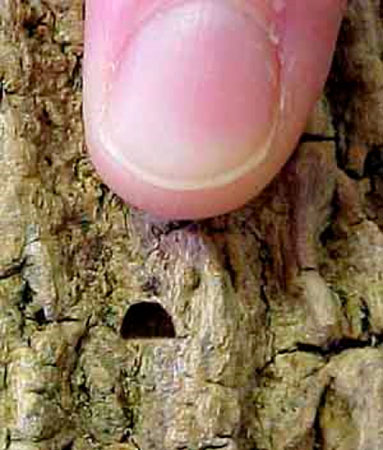Issue 10, June 25, 2010
Transporting Invasive Species--What's hiding in your tree?
The recent storms that have swept across the state have left destruction in their wake--including downed trees and limbs. We've received numerous calls about what can be done with this green waste. Many cities have organized storm pick up or maybe even a green waste recycling center. But are you aware of the dangers associated with invasive species and moving this debris and firewood? The recent emerald ash borer finds near Loda and in Loves Park brings the movement of ash trees to the forefront of some minds.

Non-native insects and diseases that have found their way into the United States are being transported long distances as "hitch-hikers" in firewood. On their own, these pests move very slowly--only a couple of miles or less per year. Unfortunately, people are innocently providing a ready means of dispersal, often several hundred miles per day, by bringing infested firewood from home to their camping, sporting, or second home destinations. Moving storm debris could have the same devastating affect.
Insects such as the gypsy moth and emerald ash borer are just two of the many different pests that are moved in firewood and wood debris. The presence of emerald ash borer in the state of Illinois has changed how firewood and forest products can be moved within our state.
Firewood Regulations in Illinois
State and federal quarantines regulate the movement of invasives in commercial forest products. The federal government has quarantined the entire state of Illinois (Adobe PDF), making it illegal to move ash products (ash trees, parts of ash trees) as well as all hardwood firewood outside of the state without federal certification. The state of Illinois has also quarantined infested areas within the state (Adobe PDF), making it illegal to move these materials out of those infested areas.
The quarantine prohibits the removal of the following items from the respective quarantine areas:
- The emerald ash borer in any living stage of development
- Ash trees of any size
- Ash limbs and branches
- Any cut, non-coniferous firewood
- Bark from ash trees and wood chips larger than 1 inch from ash trees
- Ash logs and lumber with either the bark or the outer 1 inch of sapwood, or both, attached
- Any item made from or containing the wood or the ash tree that is capable of spreading the emerald ash borer
- Any other article, product or means of conveyance determined by the Illinois Department of Agriculture to present a risk of spreading the beetle infestation.
So, as you get ready to head out to your favorite camping destinations, please remember these firewood tips.
If you purchase firewood:
- Buy it close to where it will be burned
- Make sure it is labeled with required information (commercially bought)
- Make sure it has the federal shield (examples of the USDA shield can be found in this document [Adobe PDF])
If you have your own firewood:
- Burn it close to where it was harvested/cut down
As you clean up from the recent storms, please keep in mind, the following:
- Don't move wood products across state lines
- Know if you are in the state quarantined area - and don't move wood products across these boundaries
- If you are not in the quarantined area, please still take care to not move wood products if possible.
- Also, if you are cleaning up fallen ash trees, take a look for signs and symptoms of the emerald ash borer (Adobe PDF). Homeowners are often the first to find this invasive in their own back yard!

D-shaped exit hole from emerald ash borer adult
Visit the Illinois CAPS blog for all the latest news on invasive pests in Illinois or contact Kelly Estes (kcook8@illinois.edu) with any questions.--Kelly Estes
Author:
Kelly Estes